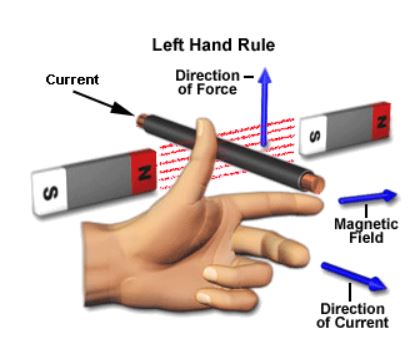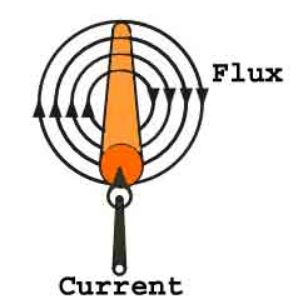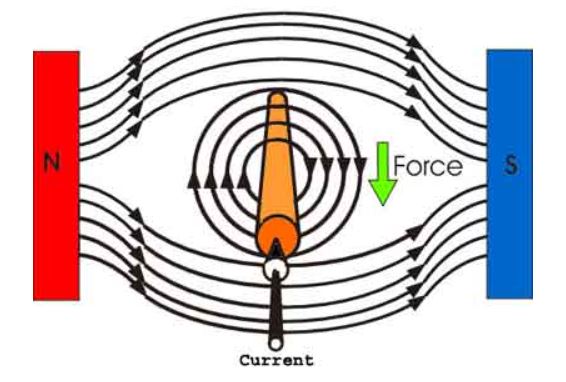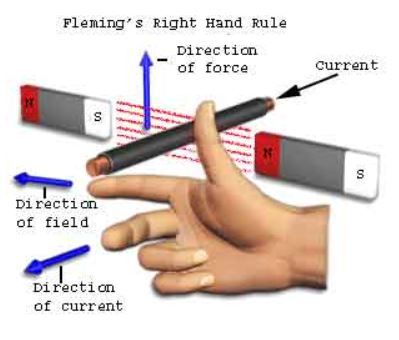Fleming’s Left Hand Rule and Fleming’s Right Hand Rule
Fleming’s Left Hand Rule and Fleming’s Right Hand Rule:
Whenever a current carrying conductor comes under a magnetic field, there will be a force acting on the conductor. The direction of this force can be found using Fleming’s Left Hand Rule (also known as ‘Flemings left-hand rule for motors’).
Similarly if a conductor is forcefully brought under a magnetic field, there will be an induced current in that conductor. The direction of this force can be found using Fleming’s Right Hand Rule.
In both Fleming’s left and right hand rules, there is a relation between the magnetic field, the current and force. This relation is directionally determined by Fleming’s Left Hand rule and Fleming’s Right Hand rule respectively.
These rules do not determine the magnitude but instead show the direction of any of the three parameters (magnetic field, current, force) when the direction of the other two parameters is known.
Fleming’s Left-Hand rule is mainly applicable to electric motors and Fleming’s Right-Hand rule is mainly applicable to electric generators.
Fleming’s Left Hand Rule
It is found that whenever a current carrying conductor is placed inside a magnetic field, a force acts on the conductor, in a direction perpendicular to both the directions of the current and the magnetic field.

In the figure below, a portion of a conductor of length ‘L’ is placed vertically in a uniform horizontal magnetic field of strength ‘H’, produced by two magnetic poles N and S. If the current ‘I’ is flowing through this conductor, the magnitude of the force acting on the conductor is:
F = BiL

Hold out your left hand with the forefinger, second finger and thumb at the right angle to one another. If the forefinger represents the direction of the field and the second finger represents that of the current, then thumb gives the direction of the force.
While current flows through a conductor, one magnetic field is induced around it. The magnetic field can be imagined by considering numbers of closed magnetic lines of force around the conductor. The direction of magnetic lines of force can be determined by Maxwell’s corkscrew rule or right-hand grip rule. As per these rules, the direction of the magnetic lines of force (or flux lines) is clockwise if the current is flowing away from the viewer, that is if the direction of current through the conductor is inward from the reference plane as shown in the figure.

Now if a horizontal magnetic field is applied externally to the conductor, these two magnetic fields i.e. field around the conductor due to the current through it and the externally applied field will interact with each other. We observe in the picture that the magnetic lines of force of external magnetic field are from N to S pole that is from left to right.
The magnetic lines of force of external magnetic field and magnetic lines of force due to the current in the conductor are in the same direction above the conductor, and they are in the opposite direction below the conductor. Hence there will be larger numbers of co-directional magnetic lines of force above the conductor than that of below the conductor.
Consequently, there will be a larger concentration of magnetic lines of force in a small space above the conductor. As magnetic lines of force are no longer straight lines, they are under tension like stretched rubber bands.

As a result, there will be a force which will tend to move the conductor from the more concentrated magnetic field to less concentrated magnetic field, that is from the present position to downwards. Now if you observe the direction of the current, force and magnetic field in the above explanation, you will find that the directions are according to the Fleming left-hand rule.
Fleming’s left–hand rule states that
“When a current-carrying conductor is placed in an external magnetic field, the conductor experiences a force perpendicular to both the field and to the direction of the current flow.”
Fleming Right Hand Rule
As per Faraday’s law of electromagnetic induction, whenever a conductor moves inside a magnetic field, there will be an induced current in it. If this conductor gets forcefully moved inside the magnetic field, there will be a relation between the direction of applied force, magnetic field and the current. This relation among these three directions is determined by Fleming’s right-hand Rule.

This rule states
“Hold out the right hand with the first finger, second finger and thumb at the right angle to each other. If forefinger represents the direction of the line of force, the thumb points in the direction of motion or applied force, then second finger points in the direction of the induced current”.
Read article – Units of Resistivity
Visit NCERTplanet.com for NCERT solutions and Textbook downloads



